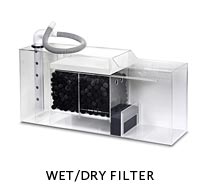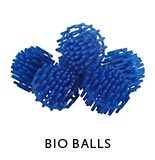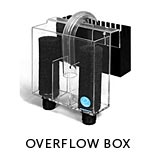Wet/Dry Filters
Among the many different types of filtration methods for aquarium owners, the wet/dry filter method is also quite popular. Wet/dry filters are also known as trickle filters. Originally a derivative of UGF filters, wet/dry filters became popular because of the limitations of UGFs.
The amount of maintenance required for a UGF is sometimes too much and that is why wet/dry filters came as a modern take on a previously well-accepted filtration method. Wet/dry trickle filters comprises of exposed filter media and vertically passing filtered aquarium water which goes over media then into a receptacle.
 The resident bacteria process the ammonia and nitrites into nitrates as water passes over the filter media.
This causes exposure to air which encourages free gaseous exchange.
The resident bacteria process the ammonia and nitrites into nitrates as water passes over the filter media.
This causes exposure to air which encourages free gaseous exchange.
These filters happen to be very efficient because they help with rapid oxidation of ammonia and nitrite. These are popular for both saltwater as well as freshwater aquariums. And that's not the only benefit these filters provide: Wet/dry filters are ideal for allowing more dissolved oxygen into the water which makes the environment inside the aquarium incredibly healthy for the fish and living beings inside.
Bio Material Clogging
Bio material clogging is a serious issue which can cause problems with filtration media. This is something that happens when debris like excess food particles and detritus clogs on the filter media and begins to decompose and results in creation of nitrates. These materials have a tendency to create nitrates which are harmful the aquarium life. This is why a pre-filter set up is important if you wish to use wet/dry filters in your aquarium. A pre-filter set up will allow you to mechanically filter the water before it is passed over media of the wet/dry filter which will ensure that no bio-balls or debris has the tendency to cause bio material clogging over media and cause toxicity in the aquarium environment.
Biological Filter Media

 Biological filter media comes in many shapes and sizes and many brand names have their own versions of it available.
These media materials go by different names and popular bio-materials include ceramic rings, bio barrels, biological media balls, bio balls and bio pin balls.
Biological filter media comes in many shapes and sizes and many brand names have their own versions of it available.
These media materials go by different names and popular bio-materials include ceramic rings, bio barrels, biological media balls, bio balls and bio pin balls.
Almost all wet/dry filters can be used along with either of these materials, but media materials do offer specific advantages and features. Features might include better aeration or more surface area. But if you buy something with more surface area there is more chance of clogging and maintenance will increase. The prices of materials are in per cubic foot and you might have to do some homework to find the right price for your wet/dry filter set up.
Bio-Material Maintenance
Even when you take care of the pre-filter set up mentioned above, and make sure you mechanically filter the water before it goes to the wet/dry filters, cleaning your biomaterial is simply unavoidable. The less careful you are about maintenance of your wet/dry filters the more problems your aquarium life might end up in because if you allow the filters to remain unclean, the debris will cause nitrates to form which will result in toxicity within the aquarium. This is why regular maintenance is a must even if you have a pre-filter set up if you need to stop the water from being contaminated. There is one important thing you need to be aware of: cleaning biomaterial will always result in loss of resident needful bacteria, but that loss is only temporary and the bacteria will restore themselves in time. What you can do to alleviate the situation is clean only a quarter portion of the biomaterial at a time.
Once the system has become well established some aquarists will prefer to remove bio-media from wet/dry filters and convert that into a sump box when that unwanted nitrate becomes a concern. A lot of people want that natural reef system which allows live rock and sand to become a main source of biological filtration. This is not impossible but you will have to consider removing the media a quarter portion at a time and the intervals need to be a week apart at least. To ensure that the system is stable, you should test for ammonia appearance in the water and keep checking this stability of biological filtration source as you complete the process of elimination.
The idea is to remove additional media only when the ammonia isn't there and the system is stable. If you find the presence of ammonia you must make sure never to remove the media until the system is stable again and ammonia is not present in the water. You might have to wait several weeks before this happens naturally and nitrifying bacteria population starts to build up. You also have to make sure not to add any more fish to this ecosystem because it can make the whole aquarium unstable. This transition period can be dangerous for your livestock if you’re not careful. Wet/dry filters are considered to be a better solution for any kind of aquarium and if maintenance routines are followed properly along with consistent water change a trickle filter is the best biological filter.